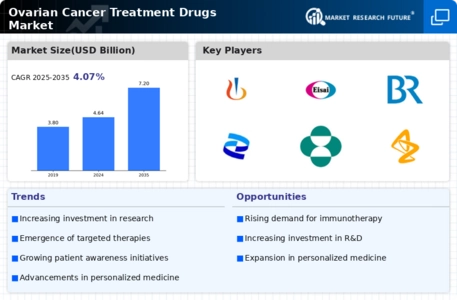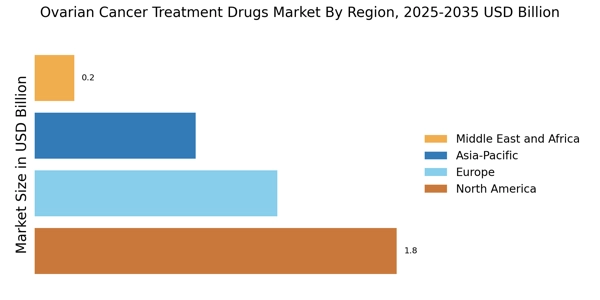Rising Incidence of Ovarian Cancer
The increasing incidence of ovarian cancer appears to be a primary driver for the Ovarian Cancer Treatment Drugs Market. According to recent statistics, the number of new cases diagnosed annually has been on the rise, with estimates suggesting that approximately 22,000 women are diagnosed each year. This alarming trend necessitates the development and availability of effective treatment options, thereby propelling the market forward. As awareness of ovarian cancer grows, more patients are seeking treatment, which in turn stimulates demand for innovative drugs. The Ovarian Cancer Treatment Drugs Market is likely to expand as healthcare providers strive to meet the needs of this growing patient population, leading to increased investments in research and development of new therapies.
Regulatory Support for Drug Approvals
Regulatory support for drug approvals is emerging as a significant driver of the Ovarian Cancer Treatment Drugs Market. Regulatory agencies are streamlining the approval process for new therapies, particularly those that demonstrate promising results in clinical trials. This expedited pathway for drug approval encourages pharmaceutical companies to invest in the development of innovative treatments for ovarian cancer. Additionally, the introduction of programs aimed at facilitating access to breakthrough therapies is likely to enhance the availability of new drugs in the market. As a result, the Ovarian Cancer Treatment Drugs Market is expected to experience accelerated growth, driven by the timely introduction of effective treatment options.
Increased Investment in Cancer Research
Increased investment in cancer research is a crucial factor propelling the Ovarian Cancer Treatment Drugs Market. Governments and private organizations are allocating substantial funds to support research initiatives aimed at understanding ovarian cancer better and developing new treatment modalities. For instance, funding for ovarian cancer research has seen a notable increase, with millions of dollars directed towards clinical trials and innovative therapies. This financial backing not only fosters the development of new drugs but also encourages collaboration between academic institutions and pharmaceutical companies. Consequently, the Ovarian Cancer Treatment Drugs Market is likely to benefit from a robust pipeline of new therapies that emerge from these research efforts.
Growing Awareness and Education Initiatives
Growing awareness and education initiatives regarding ovarian cancer are playing a pivotal role in shaping the Ovarian Cancer Treatment Drugs Market. Campaigns aimed at educating the public about the symptoms and risk factors associated with ovarian cancer are leading to earlier diagnosis and treatment. As more women become informed about the disease, they are more likely to seek medical attention, which in turn drives demand for effective treatment options. Healthcare providers are also increasingly focusing on educating patients about available therapies, further stimulating the market. This heightened awareness is expected to contribute to the growth of the Ovarian Cancer Treatment Drugs Market as more patients are diagnosed and treated.
Technological Advancements in Drug Development
Technological advancements in drug development are significantly influencing the Ovarian Cancer Treatment Drugs Market. Innovations such as high-throughput screening and artificial intelligence are streamlining the drug discovery process, allowing for faster identification of potential therapeutic candidates. These technologies enable researchers to analyze vast datasets, leading to the development of more effective and targeted therapies. Furthermore, the integration of biomarker research into clinical trials is enhancing the precision of treatment options available for ovarian cancer patients. As a result, the Ovarian Cancer Treatment Drugs Market is witnessing a surge in novel drug approvals, which could potentially improve patient outcomes and drive market growth.


















Leave a Comment